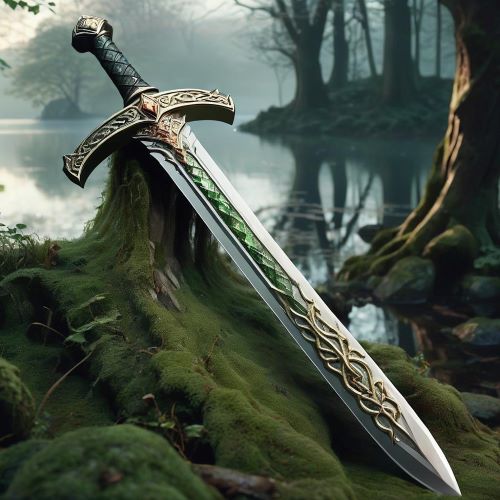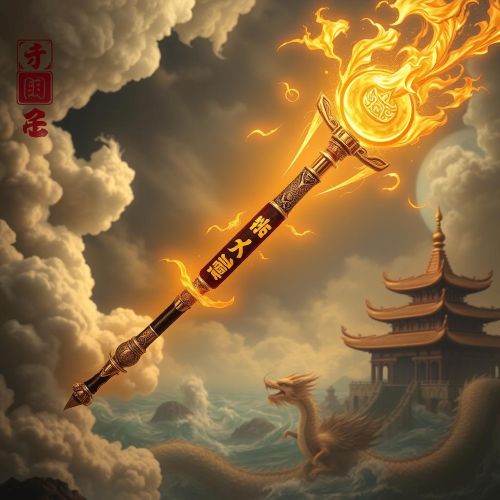Failnaught : The Magical Bow
Failnaught
Introduction
Failnaught is a legendary bow rooted in Celtic and Arthurian mythology, celebrated for its extraordinary qualities and profound ties to heroism and fate. This iconic weapon embodies the spirit of ancient warriors, featuring prominently in captivating stories that emphasize both its physical design and its deeper meanings within the folklore of these cultures. As a representation of mystical power and heroic capability, Failnaught occupies a significant place in the landscape of mythological weaponry. Its fascinating narrative spans both Celtic and Arthurian traditions, sparking intrigue and inspiration. In this article, we will delve into the origins, abilities, notable users, and legendary moments associated with Failnaught in both mythologies.
Origins
Failnaught, the legendary bow from Celtic and Arthurian mythology, is closely tied to Sir Tristan, a noble knight known for his bravery and tragic romance with Isolde. This association elevates the bow beyond a mere weapon, representing the chivalric values that Tristan embodies. Failnaught becomes a symbol of the knightly virtues of courage, honor, and loyalty, making it central to the narratives surrounding Tristan’s challenges and heroic endeavors.
More than just a tool for battle, Failnaught is said to act as an extension of the archer’s will. This idea reflects a deeper connection between the bow and its wielder, emphasizing that success with Failnaught depends not only on physical skill but on the archer’s moral integrity and intent. In this way, the bow becomes a reflection of the user’s character, reinforcing the chivalric ideal that true victory comes from righteousness and honor, not just strength.
Failnaught also carries the symbolism of fate and skill, representing the belief that those who wield it are destined for greatness. The bow ties into the broader themes of destiny present in both Celtic and Arthurian myths, where its use is not just a matter of ability but also of divine or mystical selection. This connection between the bow and a hero’s fated path highlights the intertwining of personal skill with a higher calling, suggesting that Failnaught is meant for those marked by destiny to undertake significant quests.
Steeped in myth, Failnaught’s origins trace back to Celtic traditions, crafted by druids and imbued with supernatural powers. Over time, the bow’s legend expanded into Arthurian lore, enhancing its mystique and significance. Failnaught’s journey through these mythological traditions cements its status as a powerful symbol of not only heroic skill but also the eternal battle between good and evil, making it a revered weapon in the rich tapestry of myth.
Think you know your myths and legends? Dive into the world of ancient stories and test your knowledge with our engaging quizzes on Mythlok!
Powers
Failnaught is renowned for its supernatural abilities, particularly its “unerring accuracy,” a trait that elevates it far beyond a typical weapon. The bow’s perfect aim is not just a reflection of physical skill but an embodiment of the archer’s mastery and moral integrity. In medieval tales, such precision often signifies a deeper connection to honor, suggesting that only a virtuous and skilled individual can wield Failnaught effectively. This link between the weapon and its user reinforces the idea that in the chivalric tradition, virtue and skill are inseparable.
The bow also serves as a symbol of destiny, especially in Celtic mythology, where fate plays a crucial role in the lives of heroes. Wielders of Failnaught are often portrayed as chosen by divine forces, destined for greatness within the grand narratives of their time. This connection between the individual and a larger cosmic plan suggests that Failnaught is not just a tool of war but a marker of destiny, aligning its user with a preordained path. This tension between free will and fate adds complexity to the bow’s mythological significance.
Failnaught’s ties to nature further enrich its myth. In Celtic culture, weapons like Failnaught often reflect a deep connection to the elemental forces of the natural world. The bow’s strength is thought to be drawn from these forces, amplifying its power and reinforcing the belief that nature itself plays a role in its effectiveness. This bond between the bow and the natural elements mirrors the broader Celtic belief in maintaining harmony with the world around them, suggesting that Failnaught is a symbol of balance in the cosmic order.
Celebrated for its incredible power, Failnaught was famed not only for its perfect aim but also for its ability to pierce any armor, no matter how strong or enchanted. This formidable ability made it a prized weapon in battle and legendary quests. Moreover, its arrows were said to inflict wounds that could not be healed by ordinary means, adding an element of dread to its lore. This combination of unerring precision and devastating impact made Failnaught a legendary artifact in both Celtic and Arthurian traditions.
Owners/Users
Failnaught is most famously associated with Sir Tristan, a knight of Arthur’s Round Table, whose life is marked by loyalty, love, and sacrifice. Tristan’s use of Failnaught highlights his mastery in battle and reinforces his tragic hero status, especially in the context of his forbidden love with Isolde. The bow’s exceptional accuracy aids him in crucial moments, symbolizing his connection to destiny and his role as a knight who embodies the ideals of chivalry.
In Celtic mythology, while less documented, various warriors likely wielded weapons similar to Failnaught. These heroes, known for their bravery and nobility, align with the bow’s reputation as a symbol of valor and skill. Though specific tales of Failnaught in Celtic lore are fewer, the association with such warriors underscores the weapon’s importance in stories of courage and heroism across both Celtic and Arthurian cultures.
In some versions of Celtic lore, the bow is also linked to the hero Cú Chulainn, famed for his immense strength and combat prowess. Cú Chulainn’s mastery over Failnaught reinforces the bow’s legendary status as a weapon of great power, capable of aiding heroes in their extraordinary feats. This connection further solidifies Failnaught as a central element in mythological tales of battle and destiny.
Failnaught’s legacy extends into Arthurian legend beyond Tristan, with Sir Lancelot also reputed to have wielded it. Lancelot’s unmatched skill with the bow further enhances his reputation as one of the greatest knights of the Round Table. The presence of Failnaught in both Celtic and Arthurian stories illustrates the fluid nature of myth, where iconic artifacts transcend cultural boundaries and become symbols of heroism in multiple traditions.
Instances used
Failnaught plays a key role in several iconic moments of the Arthurian legends, reflecting its significance in the stories surrounding chivalry and destiny. In the tale of Tristan and Isolde, the bow often symbolizes the struggles of their forbidden love. Its unerring accuracy helps Tristan protect Isolde and defend his honor during various conflicts, reinforcing the theme of love and sacrifice intertwined with the knight’s heroic journey.
In the context of jousting and tournaments, which are central to Arthurian tales, Failnaught becomes more than a weapon—it embodies the mental and spiritual challenges knights face. It represents not just physical prowess but also the internal strength and resolve that every knight must summon in battle, emphasizing the balance between personal virtue and martial skill.
Failnaught’s magical powers are also showcased in battles against human and supernatural foes. The bow’s role in these conflicts highlights the interplay of fate and skill, as victories often seem guided by divine forces as much as by the wielder’s abilities. Failnaught’s supernatural accuracy and power remind us of the thin line between destiny and human effort, a recurring theme in Arthurian and Celtic mythologies alike.
In Celtic mythology, Failnaught is famed for its role in Cú Chulainn’s epic battles, such as his fight against Queen Medb’s army. The bow’s ability to strike down enemies with unparalleled precision made Cú Chulainn a legendary figure, further enhancing Failnaught’s mythic status. Similarly, in Arthurian lore, Failnaught aids Sir Lancelot in defending Camelot from Saxon invaders, once again proving its value as a weapon of fate and heroism. Through these tales, Failnaught endures as a symbol of magical power, courage, and the human spirit.
Frequently Asked Questions
Lorem ipsum dolor sit amet, consectetur adipiscing?
Lorem ipsum dolor sit amet, consectetur adipiscing elit. Praesent convallis vestibulum justo, ac tincidunt nunc vehicula quis. Nullam id dolor quis orci malesuada feugiat. Curabitur aliquet libero at urna ullamcorper, ac ultricies nulla dapibus.
Lorem ipsum dolor sit amet, consectetur adipiscing?
Lorem ipsum dolor sit amet, consectetur adipiscing elit. Praesent convallis vestibulum justo, ac tincidunt nunc vehicula quis. Nullam id dolor quis orci malesuada feugiat. Curabitur aliquet libero at urna ullamcorper, ac ultricies nulla dapibus.
Lorem ipsum dolor sit amet, consectetur adipiscing?
Lorem ipsum dolor sit amet, consectetur adipiscing elit. Praesent convallis vestibulum justo, ac tincidunt nunc vehicula quis. Nullam id dolor quis orci malesuada feugiat. Curabitur aliquet libero at urna ullamcorper, ac ultricies nulla dapibus.
Lorem ipsum dolor sit amet, consectetur adipiscing?
Lorem ipsum dolor sit amet, consectetur adipiscing elit. Praesent convallis vestibulum justo, ac tincidunt nunc vehicula quis. Nullam id dolor quis orci malesuada feugiat. Curabitur aliquet libero at urna ullamcorper, ac ultricies nulla dapibus.
Lorem ipsum dolor sit amet, consectetur adipiscing?
Lorem ipsum dolor sit amet, consectetur adipiscing elit. Praesent convallis vestibulum justo, ac tincidunt nunc vehicula quis. Nullam id dolor quis orci malesuada feugiat. Curabitur aliquet libero at urna ullamcorper, ac ultricies nulla dapibus.











